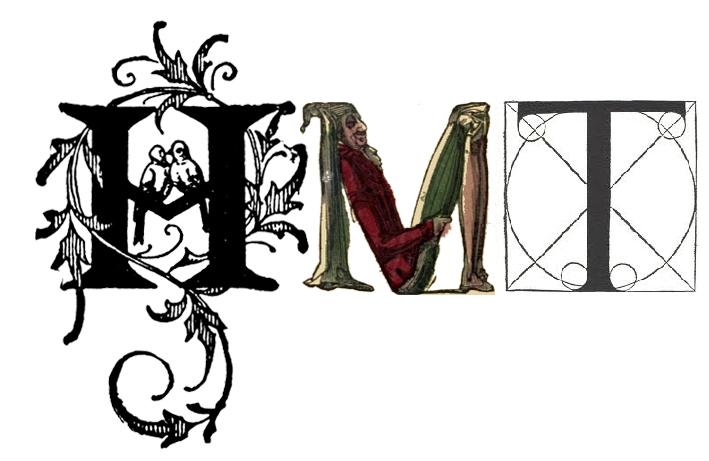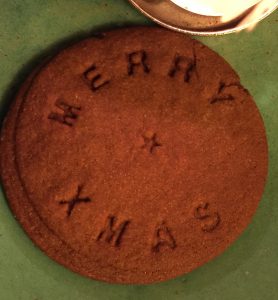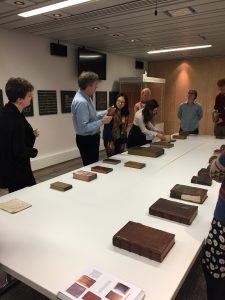Wednesday, 31st January, at 8.45 p.m.
James Carley: In the Footsteps of the King: John Leland’s Visit to York in 1541
Friends of Peterhouse Seminar Room, Peterhouse
Wednesday, 7th February, at 8.45 p.m.
Dennis Duncan: Sex and Violence and Pseudonyms: Editions du Scorpion and the Post-War Avant-Garde
Friends of Peterhouse Seminar Room, Peterhouse
Thursday, 15th February, 6 p.m. — 8 p.m.
Drinks reception as guests of G. David
An opportunity to meet exhibitors before the Cambridge Book Fair, David’s Bookshop
Wednesday, 28th February, at 8.45 p.m.
Daniel Margócsy, A Census of Vesalius
Friends of Peterhouse Seminar Room, Peterhouse
Wednesday, 7th March, at 3 p.m.
Visit to the Library of Pembroke College
Assemble at the Porter’s Lodge of Pembroke
Thursday, 15th March, at 8.45 p.m.
Informal meeting, hosted by Scott Mandelbrote, with Basie Gitlin as guest of honour
4 St Peter’s Terrace, Peterhouse
Julia M. H. Smith is giving the Birkbeck lectures at Trinity this year, dates and titles as below. Julia is currently planning on holding an open seminar on the day after the final lecture, particularly for interested graduate and early career researchers, to pick up on the topics arising from her talks, details of which will follow closer to the time.
Julia Smith (Chichele Professor of Medieval History, University of Oxford) on ‘Christianity in Fragments: the Formation of the Cult of Relics, c. 300-800.’
5 February: ‘Refashioning the Holy Land’
12 February: ‘Material Blessings’
19 February: ‘Protecting Body and Soul’
26 February: ‘Martyrs, Bones and Bodies’
All lectures take place in the Winstanley Lecture Theatre at 5.00 pm
History of Material Texts Seminar, Lent Term 2018
January 21st, 2018Seminar Series; Jason Scott-Warren
Thursday 8 February, 5 pm, Board Room, Faculty of English
Stewart J. Brookes (Cambridge), ‘Archetype: A Digital Humanities Approach to Medieval Script and Iconography’
Thursday 22 February, 5 pm, Board Room, Faculty of English
Tiffany Stern (Shakespeare Institute), ‘Playing Songs and Singing Plays: Ballads and Plays in the Time of Shakespeare’
Thursday 8 March, 5 pm, Board Room, Faculty of English
Anne Toner (Cambridge), ‘Jane Austen’s Chapters’
All welcome
Twenty years after the publication of the first of J.K. Rowling’s books about the boy who went to Hogwarts School of Witchcraft and Wizardry, the British Library is celebrating with a major exhibition which brings together an impressive array of objects and texts to explore some of the folklore, traditions, and magical histories in the world of Harry Potter.
There are mandrakes and bezoar stones, dragon eggs, mermaids, and mirrors. From the British Library’s own chamber of secrets, treasures brought out for the exhibition include a seventeenth-century manuscript that once belonged to Gabriel Harvey, which outlines ‘Howe experyments to be invysible must bee preparedd’. There is also the thirteenth-century Liber Medicinalis, containing the first documented use of ‘Abracadabra’, with an explanation of how to write the word repeatedly on successive lines, omitting one more letter each time, to create a cone-shaped amulet that could be worn around the neck to drive out fever. Readers of the Potter series will recall that magical books in Hogwarts are often emphatically material – perhaps furry, or noisy, or even violent things which might leak ink, require stroking, or at least must be handled with care. They would not be out of place alongside these intriguing testaments to ancient magical traditions chosen from the British Library’s collections.
But in some ways the most absorbing exhibits are the personal contributions from J.K. Rowling herself. There are handwritten drafts of chapters in biro on very ordinary A4 paper; typed pages of drafts with revisions by Rowling and her editor; and incredibly detailed charts that were part of her planning, showing how she managed the challenging task of weaving together very complex plots over seven books. There is a first edition paperback copy of Harry Potter and the Philosopher’s Stone annotated by Rowling, again in biro pen, with a mixture of charming illustrations and reflections on her experience of writing and rewriting. After Hermione’s encounter with a troll, for example, Rowling fills the blank space at the end of the chapter with a picture of some scissors and an unfurling ribbon, commenting: ‘This was the cut I refused to make – my editor wanted to lose the whole troll-fighting scene. I’m glad I resisted’. These material traces offer a magical glimpse into the processes involved in one of the biggest publication successes of the twentieth century.
A snap from the second of David Pearson’s masterclasses on early modern bookbindings, held last week in the Cambridge University Library. The classes were a reminder that a rare books library is an extraordinary collection of dead animal skins, a mausoleum for the thousands of pigs, sheep, cows and goats that gave their lives in part to make words on paper more durable. The sessions were also an encounter with the mystery of design, as they traced the changing decorative fashions that allow a trained eye to date a binding quite precisely to a particular period.
Somewhere inside me I still have a logocentric self that thinks bindings don’t matter–they are just there to serve the words. Perhaps that is reinforced by the fact that the vast majority of bindings are distinctly plain and functional, turning the book into something sturdy and everyday. But to face up to the scale of the premodern binding trade, and of the extraordinary price-differentiation of the products that it produced, is to realise that books were once choice objects, things to flash around as evidence of wealth, taste and social status. Our thanks to David for making this sometimes arcane world accessible once more.
I’ve just written a blog-post for the Cambridge University Library rare books site, on an extraordinary seventeenth-century book that was the library’s first purchase from ebay. You can read it here:
https://specialcollections.blog.lib.cam.ac.uk/?p=15246
author.net: A cross-divisional conference on distributed authorship
October 11th, 2017Calls for Papers, News; Jason Scott-WarrenUCLA, October 5th-6th 2018
Organizers:
Sean Gurd, Professor of Classics, University of Missouri
Francesca Martelli, Assistant Professor of Classics, UCLA
DEADLINE FOR ABSTRACTS: January 15, 2018
Distributed authorship is a familiar concept in many fields of cultural production. Long associated with pre-modern cultures, it still serves as a mainstay for the study of Classical antiquity, which takes ‘Homer’ as its foundational point of orientation, and which, like many other disciplines in the humanities, has extended its insights into the open-endedness of oral and performance traditions into its study of textual dynamics as well. The rise of genetic criticism within textual studies bears witness to this urge to fray perceptions of the hermetic closure of the written, and to expose the multiple strands of collaboration and revision that a text may contain. And the increasingly widespread use of the multitext in literary editions of authors from Homer to Joyce offers a material manifestation of this impulse to display the multiple different levels and modes of distribution at work in the authorial process. In many areas of the humanities that rely on traditional textual media, then, the distributed author is alive and well, and remains a current object of study.
In recent years, however, the dynamic possibilities of distributed authorship have accelerated most rapidly in media associated with the virtual domain, where modes of communication have rendered artistic creation increasingly collaborative, multi-local and open-ended. These developments have prompted important questions on the part of scholars who study these new media about the ontological status of the artistic, musical and literary objects that such modes of distribution (re)create. In musicology, for example, musical modes such as jazz improvisation and digital experimentation are shown to exploit the complex relay of creativity within and between the ever-expanding networks of artists and audiences involved in their production and reception, and construct themselves in ways that invite others to continue the process of their ongoing distribution. The impact of such artistic developments on the identity of ‘the author’ may be measured by developments in copyright law, such as the emergence of the Creative Commons, an organization that enables artists and authors to waive copyright restrictions on co-creators in order to facilitate their collaborative participation. And this mode of distribution has in turn prompted important questions about the orientation of knowledge and power in the collectives and publics that it creates.
This conference seeks to deepen and expand the theorising of authorial distribution in the virtual domain, and to explore the insights that its operations in this sphere might lend into the mechanisms of authorial distribution at work in older (and, indeed, ancient) media. To this end, it will bring together scholars working in the fields of communication and information technology with scholars working across the humanities, in order to explore what kind of dialogue we might generate on the question of distributed authorship across these disciplinary (and other) divisions. Ultimately, our aim is to develop and refine a set of conceptual tools that will bring distributed authorship into a wider remit of familiarity; and to explore whether these tools are, in fact, unique to the new media that have inspired their most recent discursive formulation, or whether they have a range of application that extends beyond the virtual domain.
We invite contributions from those who are engaged directly with the processes and media that are pushing and complicating ideas of distributed authorship in the world today, and also from those who are actively drawing on insights derived from these contemporary developments in their interpretation of the textual and artistic processes of the past, on the following topics (among others):
- The distinctive features of the new artistic genres and objects generated by modes of authorial distribution, from musical mashups to literary centones.
- The impact that authorial distribution has on the temporality of its objects, as the multiple agents that form part of the distribution of those objects spread the processes of their decomposition/re-composition over time.
- The re-orienting of power relations that arises from the distribution of authorship among networks of senders and receivers, as also from the collapsing of ‘sender’ and ‘receiver’ functions into one another.
- The modes of ‘self’-regulation that authorial collectives develop in order to sustain their identity.
- Fandom and participatory culture, in both virtual and traditional textual media.
- The operational dynamics of ‘multitexts’ and ‘text networks’, and their influence by and on virtual networks.
Paper proposals will be selected for their potential to open up questions that transcend the idiom of any single medium and/or discipline. Please send a proposal of approximately 500 words to gurds@missouri.edu by January 15, 2018.
Confirmed participants include:
Mario Biagioli, Distinguished Professor of Law and Science and Technology Studies, and director of the Centre for Science and Innovation Studies, UC Davis (author of Galileo Courtier, Chicago 1993; and editor, with Peter Galison, of Scientific Authorship, Routledge 2003).
Georgina Born, Professor of Music and Anthropology, Oxford University (director of Music, Digitisation, Mediation: Towards Interdisciplinary Music Studies, or MusDig: http://musdig.music.ox.ac.uk).
Christopher Kelty, Professor of Anthropology, Information Studies, and at the Institute for Society and Genetics, UCLA (author of Two Bits: the Cultural Significance of Free Software, Duke 2008).
Scott McGill, Professor of Classics, Rice University (author of Virgil Recomposed: the Mythological and Secular Centos in Antiquity, Oxford 2005; and Plagiarism in Latin Literature, Cambridge 2012)
Daniel Selden, Professor of Literature, UC Santa Cruz (author of numerous articles, and a forthcoming book, on the phenomenon of ‘text networks’ in the long Hellenistic period)
Fascinating article by Huang Yuan in the latest London Review of Books about the tightening of censorship regimes in China. ‘The Economist often receives phone calls from Chinese subscribers to the print edition complaining about missing issues (especially when the cover shows a panicky Xi Jinping astride a stumbling dragon). And it’s not uncommon for pages with critical reports about China to be torn from the magazine before subscribers get it (we have no shortage of manpower for this labour-intensive task). The New York Review of Books–always critical of China, and sharing many contributors with the New York Times–has so far dodged the censor, most likely because the number of subscribers is too low for the censors to condescend to’.
History of Material Texts seminars, Michaelmas 2017
October 3rd, 2017Seminar Series; Jason Scott-Warren
Thursday 26 October, 5 pm, Board Room, Faculty of English
Orietta da Rold (Cambridge), ‘A paper on (premodern) paper’
Thursday 16 November, 5 pm, Board Room, Faculty of English
John Gagné (Sydney), ‘Paper, Time, and Oblivion in Premodern Europe’
Thursday 23 November, 5 pm, Board Room, Faculty of English
Dennis Duncan (Munby Fellow, CUL), ‘Nitpickers vs Windbags: Weaponising the Book Index, 1698-1730’
Monday 27 November, 11.30 am-1 pm & Tuesday 28 November, 11.30 am-1 pm
Milstein Seminar Room, CUL
David Pearson (London), ‘Telling the sheep from the goat: a brief guide to historic bookbindings (1450-1800) for humanities researchers’
(please email jes1003@cam.ac.uk to prebook for these masterclasses)


